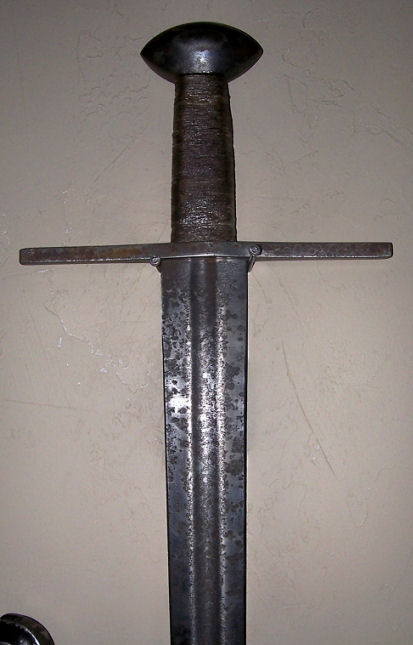Hi all, Iím new here,
But I have been fascinated by arms & armor my whole life!
This seems like the right place to answer this question?
Iíve just finished my first attempt at blacksmithing by making a reproduction hilt for an antique blade (Pommel & cross guard). The blade would likely be called excavated condition, heavy pitting and that deep crusty ĎblackenedĒ rust.
Is there any quick way to recreate that type of patina on freshly hammered steel?
Iíve already beat the pieces with broken concrete and gave them some small irregular nicks & pits and I've been soaking it in moist salt for a week. But I donít want to wait for hundreds of years to finish this project :D
Perhaps someone here may have some better ideas to reproduce that deep pitting?
Thanks in advance!
-Kirk
If you have a look at the features section on this web-site there is a good article called The Instant Antique. Amongst other things it mentions the use of vinegar in solution with the salt. I have just been trying this out on a cheap Roman helmet that I was getting bored with and it is working a treat. The acid really attacks the metal.
Cheers,
Darrin.
Cheers,
Darrin.
make a bath of hydrogen peroxide and salt. Let it sit in there for a couple days. Empty it and replace the solution. Trust me. It works. The 2 react with eachother creating oxygen and increases the rate of oxidation. This was my light aging to give it an "above the tomb of a knight" look. I also rewrapped the grip with hemp cord and sealed it with glue.
If you want pictures of the process PM me. Just a word of caution. It will get messy.
 Attachment: 56.32 KB
Attachment: 56.32 KB

If you want pictures of the process PM me. Just a word of caution. It will get messy.

Thanks guys!
Darrin, I read the article and my parts are soaking now.
Michael, Thatís the look Iím going for, especially the way your blade turned out.
Thanks again,
-Kirk
Darrin, I read the article and my parts are soaking now.
Michael, Thatís the look Iím going for, especially the way your blade turned out.
Thanks again,
-Kirk
Just plain yellow mustard is very aggressive and a couple of hours is like a few decades of aging I think.
For a very corroded look I would try something like 24 hours ! ( I'm scared to think what that would look like ).
My old lemon juice method is more slow acting and with the use of toilet paper with an interesting texture the results were more like etched simulated Damascus than the more or less corroded look of mustard daubed on the surface.
Some steels resist more than others though and take more time to pit & rust.
Mustard seemed to rust the surface more and lemon juice stain/etch the metal dark gray but not produce any red rust that I could notice.
For a very corroded look I would try something like 24 hours ! ( I'm scared to think what that would look like ).
My old lemon juice method is more slow acting and with the use of toilet paper with an interesting texture the results were more like etched simulated Damascus than the more or less corroded look of mustard daubed on the surface.
Some steels resist more than others though and take more time to pit & rust.
Mustard seemed to rust the surface more and lemon juice stain/etch the metal dark gray but not produce any red rust that I could notice.
Page 1 of 1
You cannot post new topics in this forumYou cannot reply to topics in this forum
You cannot edit your posts in this forum
You cannot delete your posts in this forum
You cannot vote in polls in this forum
You cannot attach files in this forum
You can download files in this forum
All contents © Copyright 2003-2006 myArmoury.com — All rights reserved
Discussion forums powered by phpBB © The phpBB Group
Switch to the Full-featured Version of the forum
Discussion forums powered by phpBB © The phpBB Group
Switch to the Full-featured Version of the forum